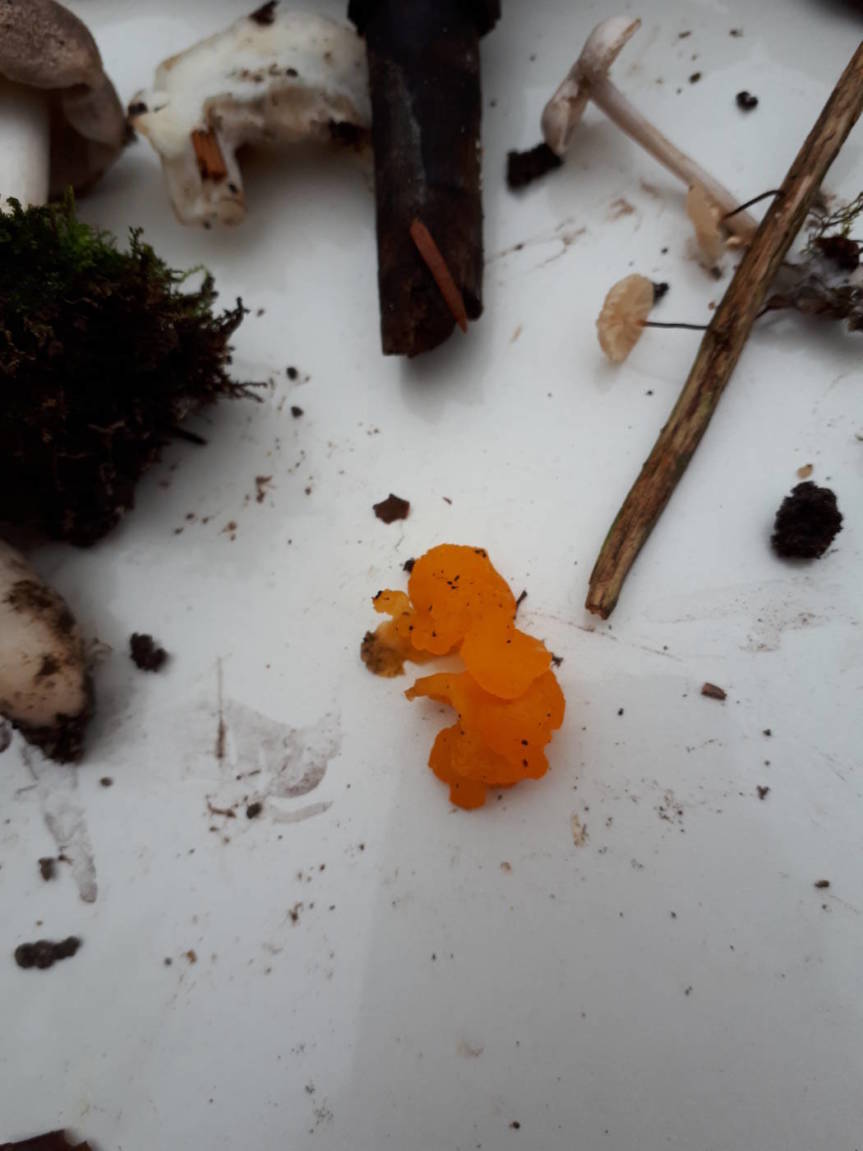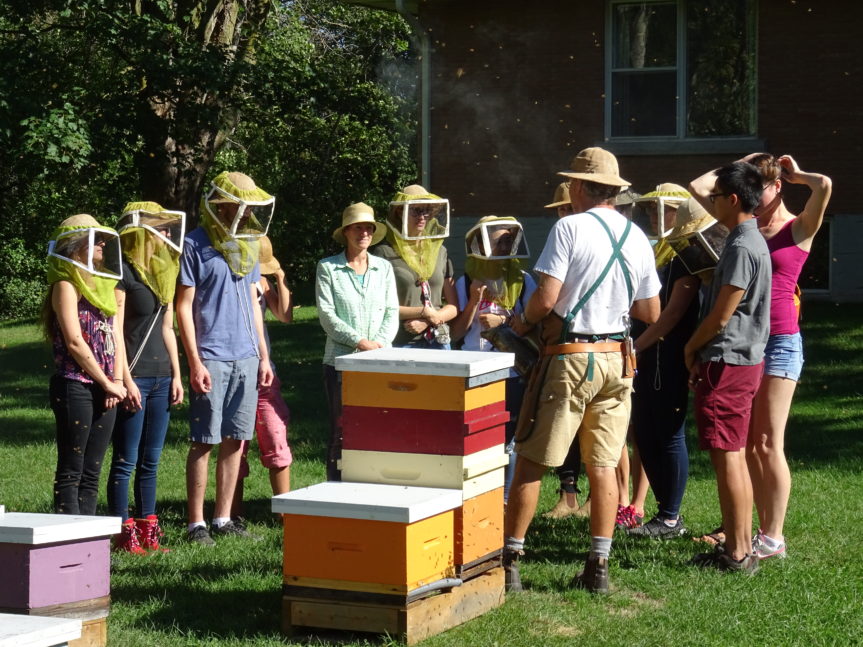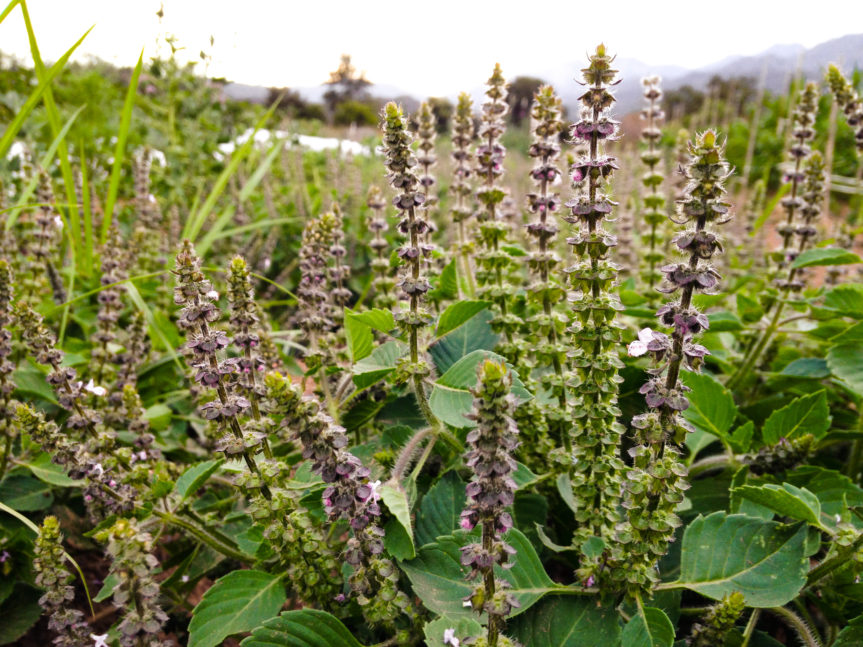 Some pictures i have gathered during tis lovely harvest season, between the beginning of september and the middle of october!
Some pictures i have gathered during tis lovely harvest season, between the beginning of september and the middle of october!

































Category: Outdoor Topics
-

Pictures from harvest season
-
Podcast: On Language, Invasion and Colonization
Bioinvasion: Attack of the Alien Species
BONUS:
CBC Quirks and Quarks Podcast: Why Invasive Species Aren’t All BadVICE video: The Worst Fish in America: Asian Carpocalypse
-
Mushroom Foray Day
Adding on to Diane’s post, here are some extra photos from the perspective of someone who has never participated in a mushroom foray! On October 15, our Outdoor School class spent the morning foraging for mushrooms in the UofG Arboretum. For most of us, it was the first time we went into a forest to search and collect fungi of various species. Although some of us had midterms, foraging for mushrooms and other fungi was a good way to relax and stay calm before the examinations. When we arrived at the Arboretum, we got our baskets and headed into the forest to see if we could find different specimens to bring back to show everyone.
Many of the fungi we found were mushrooms, but there were others such as, slime moulds, polypores, and jelly fungi. There was even a stinkhorn that gave off a horrendous smell that many of us would never forget as well as some poisonous species.
It was amazing to see the many different species of fungi that were collected during the foray. It really showed me how diverse the Arboretum ecosystem is and I honestly didn’t expect to find so many mushrooms all in one area. The puffball mushrooms were especially surprising as I’ve never seen a mushroom that huge and it also kind of resembles a human skull, which is something I will definitely remember. Overall, the foray was an excellent learning experience that raised my awareness and appreciation of species in the fungi kingdom!
-

Outdoor School: Honey Bees and Catching Insects
On September 20, 2016, our Outdoor School class visited the University of Guelph’s very own apiary and honey bee research centre. We put on our beekeeping hats and veils, and were shown the hives that contained thousands of busy honey bees. We were able to pet the bees, taste their fresh honey and eventually take home a bottle of honey that was extracted right from the apiary.
After visiting the bees, we walked through the Arboretum to the learning centre where we learned how to catch insects and identify them.
We saw and learned about many other insects such as jumping spiders, milkweed bugs, wasps, bees, moths and beetles. Overall, it was a very productive day that involved a lot of walking and getting up close and personal with different species from the largest group of animals!
-

Deep Time, Radical Camping: Notes from a walk at Mono Cliffs
Notes from the Outdoor School field trip to Mono Cliffs Provincial Park on October 2nd, 2015, with some observations about the landscape and a lecture on radical camping.
by Amish Morrell

Mono Cliffs Provincial Park. We started at the top of Walter Tovell side trail, ate apples and climbed trees on our way to the lookout (at the scissor tips), where we could see Toronto, swam, skipped stones and picnicked at McCarston’s Lake, and ended on 3rd Line, near the South Outlier. We began on a side-trail of the 850 km-long Bruce Trail, and walked to the edge of a 450 million year old sea that once spread from upstate New York to Michigan, when there was no terrestrial life, and the days were only 21 hours long. Looking down into the rock beneath our feet, we found it to be full of the fossilized traces of ancient lifeforms. Looking to the right, to the West, we could see the more recent traces of the Wisconsin ice-sheet, a glacier that stood two kilometres deep and left sand and gravel and ice as it retreated 12,000 years ago, forming the Orangeville Moraine. One piece of ice stayed buried in the glacial till, forming a lake as it melted, where we swam and skipped stones. Straight ahead of us, to the South, we could see a small mountain, with caves and rocks spires along its perimeter, that was formed when rivers poured off the glacier, severing it from the former shoreline. A hundred kilometres beyond this bump on the horizon we could faintly see the black shapes of the Mies Van Der Rohe-designed towers in downtown Toronto, built in the late 1960s. Had the atmosphere been a little clearer, we would have been able to make out the CN Tower as a tiny hair on the horizon.
To the South lay the rivers and brooks that flow into Toronto, creating one of the largest urban ravine systems in the world. In one of these ravines, in the late 1800s, a kid named Ernest Tompson Seton built a shanty in the outskirts of the city in what is now either Rosedale Ravine, or Moore Park Ravine, or on another brook that flows into the Don River. Thompson mythologized his time spent in the Don Valley with a racist children’s novel called “Two Little Savages” describing the adventures of two boys who pretended to be Indians, and filled with his own illustrations, that he published in 1903. In 1906 he published The Birchbark Roll of the Woodcraft Indians as a series of article in the Ladies Home Journal, using the figure of the Indian and ideas of nature-pantheism as a path to social and moral reform, at a time when real First Nations peoples were being persecuted for the practices Seton was appropriating. Seton, who had met and was influenced by the Russian anarchist Peter Kropotkin and his ideas about cooperation, was staunchly anti-capitalist, believed in communal living and saw nature as a vehicle for moral instruction. Based on these ideas, he formed the League of Woodcraft Indians, and in 1910 became the head of the Boy Scouts of America, a position he left in 1915 after disagreement with Lord Baden Powell, who lead a parallel British organization and who supposedly plagiarized Seton’s Birch Bark Roll, replacing the figure of the Indian and nature-worship with militarism and Christianity.
Seton’s Woodcraft Movement influenced a number of other organizations that combined radical politics and outdoor living. These include the early 20th-century group called the Order of Woodcraft Chivalry, which was founded by Quakers and which emphasized kindness, fellowship, and conservation. Others included the Kindred of the Kibbo Kift and The Forest School Movement. Formed in 1920, the Kibbo Kift, according to Matthew De Abbitua in his book The Art of Camping, “attracted disaffected Scouts, left-wingers, former suffragettes, theosophists, vegetarians and artists.” (106). Emphasizing open air education, health of body mind and spirit, craft skills, cultural development and pacifism, the Kindred reflected these ideas in their symbology, with the K describing a yoga-like physical stance that represented openness to the sun and to knowledge, and holding an annual open-air assembly, called the Althing, which drew its name from the Icelandic Parliament at Pingvellir. Members of the Kibbo Kift made their own tents, hiking outfits and ceremonial costumes, sometimes consciously drawing from Constructivist designs, and including brightly coloured and embellished with bold patterns and badges. By the 1930s, the Kibbo Kift began to evolve into a political organization, leading to the formation of Britain’s Social Credit Party.

Kindred of the Kibbo Kift, in Costume, 1930s 
Member of the Kindred of the Kibbo Kift, in ceremonial attire. circal 1920s. 
British artist Oliva Plender, performance, part of “Machine Shall Be the Slave of Man, but We Will Not Slave for the Machine” at the Tate Triennial, 2009 There were other organizations that embraced camping. In the 1890s, organizations such as the proletarian Naturfreunde, which had as its slogan “Free the Mountain” saw one of the crises of capitalism as being workers alienation not just from ownership over labour, but alienation from nature. Combining Marxism and a semi-religious view of nature, hiking groups functioned as workers academies, where people discussed topics from socialism to history and botany, emphasizing nature as a site of self-education, where one “learned from the book of nature whose pages are turned by the feet (Alexander, 81).

Oliva Plender, from “Machine Shall Be the Slave of Man, but We Will Not Slave for the Machine” at the Tate Triennial, 2009 Similarly, there were exclusively youth-focused groups, such as the Wandervogel, or the Wandering Birds, which began in 1887 as a high-school stenography club, whose members saw a tombstone epitaph while out on a hike that read “Who gave you wandering birds the knowledge never to go astray” (Alexander, 124). Made up of teenagers, mostly of the middle-class, they rejected mass-production and consumerism, researched folk and craft traditions, and sought freedom from adult control through unsupervised hiking and camping, known as “wild hiking.”

Wandervogel, early 20th c. Another group, called Der Anfang (The Beginning), which began in 1913, organized salons and published a journal that criticized the education system, the church, the family and the military and advocated for youth culture, free of adult control, where nature was a site of freedom and exploration (135). Writing under a pseudonym for the journal that Der Anfang published, one of their members, Walter Benjamin, who was then a high school student, wrote “We are seized by the feeling that youth lasts only one brief night, so fill it with ecstasy!” By the First World War, there were tens of thousands of mostly German youth of both genders participating in camping organizations like the Wandervogel or unsanctioned forms of wild hiking.

Wandervogel, early 20th c. Source unknown. With Germany in severe economic recession by the late 1920s, the Wandervogel began to fragment, with some members become proto-hippies, forming the Ascona commune, a gathering point for intellectuals and cultural figures in Monte Verita, Italy (the subject of an exhibition curated by Harald Szeemann in 1978), and others becoming proto-fascists, joining organizations like Germany’s White Knights (Savage & Ryan). Another effect was the organization of urban and exurban groups of “Wild Boys,” formed among the more than 14,000 homeless teenagers who lived in the outskirts of Berlin and in other parts of Germany, taking on names like “Blood of the Trappers, “Black Love,” and “Forest Pirates,” “Edelweiss Pirates” and “Shambeko Band” often after the North American frontier novels of Karl May. The Wild Boys had strict social hierarchies, lead by an older boy, called a “Bull,” with a younger boy called a “Queen” who was a servant and sexual slave to the others, and subjected their initiates to feats of physical strength, blood oaths and sado-sexual rituals (Gordon, 96).

Wild Boys Initiation ritual, 1920s. The Wild Boys, who made their living largely through burglery and prostitution, had a distinctive style, described in 1923 by the French journalist Daniel Guerin as often including “black or grey Chaplinesque bowlers, old women’s hats with the brims turned up Amazon-fashion, adorned with ostrich plumes and medals… handkerchiefs or scarves in screaming colors tied any which way around the neck, bare chests bursting out of open skin vests with broad stripes, arms scored with fantastic or lewd tattoos, ears hung with pendulums or enormous rings, leather shorts surmounted by immense triangular belts daubed with all the colors of the rainbow, esoteric numbers, human profiles, and inscriptions such as Wild-frei [wild and free] or Rauber [bandits].” (quoted in Savage & Ryan)

Winnetou, Ring Bull of one of the Wild Boys. During World War II, many youth including Winnetou were conscripted into Nazi organizations. Others resisted, and hiking and camping took on heightened political meaning as the Nazis forbid any hiking that was not part of the activities of the Hitler Youth. The Edelweiss Pirates composed anti-Nazi songs, clashed with Hitler Youth organizations, and formed an armed resistance made up concentration-camp escapees, deserters, and forced labourers (Savage & Ryan).
There we have it, politics, style, sexuality, and camping. A seemingly unlikely convergence, but important predecessors for artistic movements and countercultures that evolve throughout the 20th century, and a far cry from today’s commercialized and competitive ideologies of camping and hiking as leisure and athleticism.
Sources:
Matthrew de Abaitua, The Art of Camping: The History and Practice of Sleeping Under the Stars (Hamish Hamilton, 2011)
Beth Gilhespy, “Escarpment Geology: Another part of our Living Landscape” Bruce Trail Magazine, Spring 2015.
Mel Gordon, Voluptuous Panic: The Erotic World of Weimer Berlin (Port Townsend WA: Feral House, 2008).
Jon Savage and Johnny Ryan, “Remembering the Wandervogel,” VICE online, March 1, 2011. http://www.vice.com/en_ca/read/remembering-the-wandervogel-728-v18n3/page/0
Harald Szeemann, Le mammelle della verità (“The Breasts of Truth”), 1978. See: http://www.monteverita.org/en/32/museum-complex.aspx
John Alexander Williams, Turning to Nature in Germany: Hiking, Nudism, and Conservation, 1900 – 1940 (Stanford UP: 2007)
-

Tulsi or Holy Basil
I’ve been purchasing Holy Basil or Tulsi from the organic market on campus for a few years. After Andrew and I visited the Organic Farm on campus for our club research and we were able to help harvest and prep produce for the market, we decided to make some Tulsi tea with fresh herbs sourced on campus to share with the outdoor school class. A number of students enjoyed and were interested in the healing properties of Tulsi or Holy Basil – so here’s some information:

tulsi or holy basil (Ocimum sanctum) While basil is found on every continent, tulsi or holy basil (Ocimum sanctum) is indigenous to the Indian subcontinent. It is a bushy shrub that grows to about 18 inches in height. Its leaves are oval and serrated, with colors ranging from light green to dark purple, depending on the variety. In the wild, tulsi is an annual, but it can be kept as a perennial by trimming it before it forms seeds. The plant has delicate lavender-colored flowers, and its fruit consists of tiny rust-colored nuts.
Often referred to as holy basil, Tulsi is a potent herb that has been used in India for thousands of years to treat colds, coughs, and flu. According to Ayurveda**, tulsi promotes purity and lightness in the body, cleansing the respiratory tract of toxins and relieving digestive gas and bloating. Tulsi leaves offer a rich source of essential oil, containing eugenol, nerol, camphor, and a variety of terpenes and flavonoids. The oil is a strong antiseptic against many kinds of disease-causing organisms, including bacteria, fungi, and parasites.
In terms of the Ayurvedic doshas, tulsi carries the bitter, pungent, and astringent tastes and generates a warming influence on the physiology. The herb is predominantly Kapha-reducing, but it can also be used to pacify Vata and Pitta. However, it can have a mildly Pitta-aggravating effect in individuals who are severely overheated.Tulsi has spiritual as well as medicinal significance in Ayurveda. In Hindu mythology, the plant is an incarnation of the goddess Tulsi, offering divine protection. Many Indian families keep a living Tulsi plant in their homes – tending to it with great care and reverence. The plant’s woody stalks are often made into beads used in meditation malas or rosaries.
- via: www.chopra.com
Tulsi Tea:
If you are looking for Tulsi as a pre-packaged tea it can be found in tea bags in a number of stores in Guelph. A good place to start would be the Stone Store or to visit New Age. If you would like the plant fresh – visit the Orangic Market Thursdays on campus (while there is still harvest) 3-6pm near Rozanski and purchase a bunch for $1.50. I ‘process’ the herbs by separating the flowers and leaves and drying them in baskets. I use the leaves for cooking and the flowers for tea. Alternatively you can hang the whole bunch upside down in your kitchen and just break off what you need.
** For anyone unfamiliar with Ayurveda – it is is a 5,000-year-old system of natural healing that has its origins in the Vedic culture of India.
-

Cloud Appreciation
Clouds influence the lives of humans on a daily basis yet it is so common that they are overlooked and under appreciated. Today I Googled “cloud” and my search turned up hundreds of articles about “icloud”, “cloud computing”, and “cloud storage”.
We sensationalize the enigmatic nature of these fluffy objects by naming our computer software after them. However, for most Canadians, our cloud education ends after grade school. Luckily, that does not mean we cannot return to appreciate clouds later on in life.
The term “cloud” is defined in the Marriam-Webster English Dictionary as a visible mass of particles of condensed vapour (as water or ice) suspended in the atmosphere of a planet (as the earth) or moon.
I have assembled a brief list of cloud genera to refresh my fellow colleagues and peers:
Cloud Basics:
There are three levels of common clouds to know: high clouds, mid clouds, and low clouds.
High clouds include:
1. Cirrus
-detached, white filaments
-mostly in patches or bands
-composed of ice crystals

2. Cirrostratus
-smooth, hair-like appearance
– transparent and covers most of the sky

3. Cirrocumulus
-layered thin clouds
-appearance of grains or ripples in the texture

Mid clouds include:
1. Altostratus
-striated or fibrous clouds that cover most of the sky
-dark grey or blue in colour
-occasionally reveals the sun

2. Altocumulus
-layered clouds in the form of round masses or rolls
– may be fibrous or diffuse
-white and/or grey in colour

3. Nimbostratus
-diffuse cloud base
-dark grey, often recognized as a rain cloud
-thick enough to block the sun

Low clouds include:
1. Cumulus
-dense with sharp outlines
-develop vertically
-sections that light hits are bright white, the rest is grey

2. Cumulonimbus
-upper portion smooth and fibrous
-dense, appears in the form of a mountain

3. Stratus
-grey with a uniform base
-produces drizzle, ice grains, and snow prisms

4. Stratocumulus
-patchy clouds with dark tessellations
-rounded masses or rolls

As I was refreshing my knowledge of clouds, I happened upon this very interesting blog post on rare cloud formations. When you start to appreciate clouds, your world becomes more enriched. Identify a cloud the next time you are outside!
-
Guelph Arboretum’s Chris Earley doing Stand-Up Bird Calls
See the Arboretum’s You Tube Channel here.
Talk to Diane if you would like to submit a work of video art to the Arboretum’s channel.



















You must be logged in to post a comment.